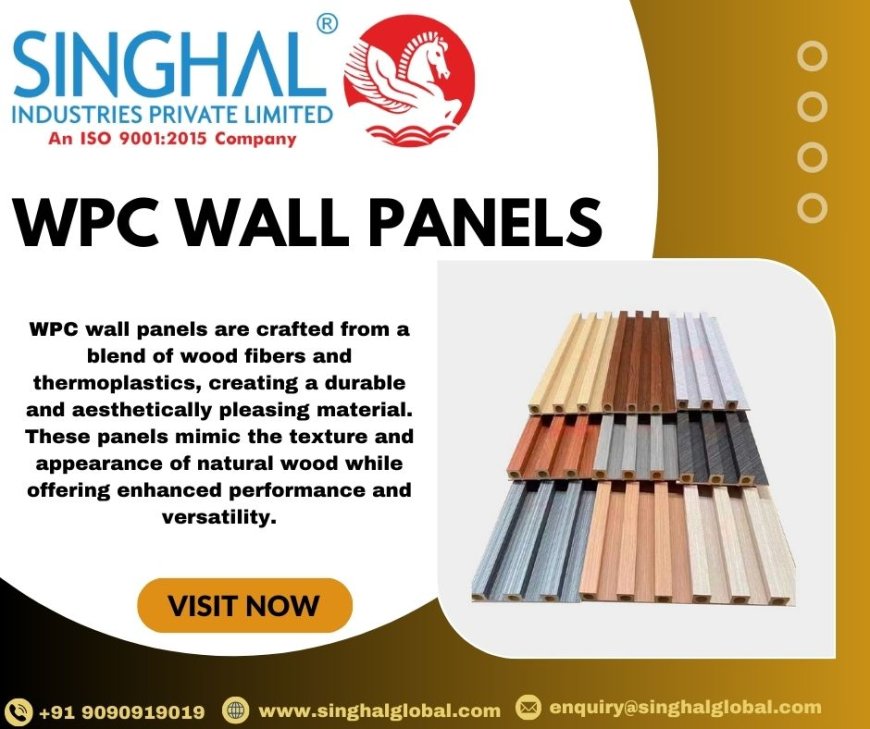A Comprehensive Guide to WPC Wall Panels: Features, Benefits, and Installation
A Comprehensive Guide to WPC Wall Panels: Features, Benefits, and Installation

In the world of modern construction and interior design, WPC (Wood-Plastic Composite) wall panels have gained significant popularity due to their versatility, durability, and aesthetic appeal. This comprehensive guide delves into the features, benefits, and installation of WPC wall panels, providing insights into how they can enhance both interior and exterior spaces.
What Are WPC Wall Panels?
WPC wall panels are made from a blend of wood fibers and plastic materials, combining the best attributes of both to create a product that is both robust and aesthetically pleasing. The wood fibers offer a natural look and feel, while the plastic components ensure durability and resistance to environmental factors.
Features of WPC Wall Panels
-
Durability: WPC wall panels are highly resistant to moisture, termites, and decay, making them an ideal choice for areas with high humidity or variable weather conditions. This durability also translates to a longer lifespan compared to traditional wood panels.
-
Aesthetic Appeal: These panels are available in a variety of designs, colors, and textures. Whether you’re looking for a sleek modern finish or a traditional wood-like appearance, WPC panels can mimic the look of natural materials while offering superior performance.
-
Low Maintenance: Unlike traditional wood panels, WPC panels require minimal upkeep. They do not need regular staining or sealing, and cleaning them is as simple as wiping them down with a damp cloth.
-
Eco-Friendly: WPC panels are made from recycled wood and plastic materials, making them an environmentally friendly choice. By opting for WPC, you contribute to reducing waste and conserving natural resources.
-
Fire Resistance: Many WPC panels are treated with fire-resistant properties, which can provide an additional layer of safety for your home or commercial space.
Benefits of WPC Wall Panels
-
Cost-Effective: While the initial cost of WPC wall panels might be higher than some traditional materials, their durability and low maintenance needs can lead to cost savings over time. You won’t have to worry about frequent repairs or replacements.
-
Versatility: WPC panels are suitable for both interior and exterior applications. They can be used in a range of settings, from residential homes to commercial buildings, and can even be adapted for use as wpc exterior wall panels.
-
Easy Installation: WPC wall panels are designed for ease of installation. They often come with a simple interlocking system or can be mounted using adhesive, reducing labor time and associated costs.
-
Improved Insulation: WPC panels can help improve the insulation of a space, contributing to better energy efficiency. They can provide additional thermal insulation, helping to maintain a consistent indoor temperature.
-
Customization: With a wide range of Wpc Sheet Design options available, you can tailor the appearance of your walls to match your desired aesthetic. From sleek, modern finishes to more rustic, natural looks, there’s a WPC design to fit any style.
Installation of WPC Wall Panels
Installing WPC wall panels is a straightforward process, but proper preparation and execution are key to achieving the best results. Here’s a step-by-step guide to help you through the installation:
1. Preparation
Before installation, ensure that the wall surface is clean, dry, and free from any debris. It should be smooth to ensure that the WPC panels adhere properly.
2. Measuring and Cutting
Measure the wall area where the panels will be installed. Based on your measurements, cut the WPC panels to fit the space. Most panels can be cut using standard woodworking tools, but it’s essential to follow the manufacturer’s guidelines to ensure a clean cut.
3. Applying Adhesive
If your panels are designed to be glued, apply a high-quality adhesive to the back of each panel. For interlocking panels, ensure that the grooves and tongues are aligned properly.
4. Mounting Panels
Start mounting the panels from one corner of the wall, working your way across. Press each panel firmly into place and ensure that they are level as you proceed. For interlocking panels, ensure that each panel clicks into place securely.
5. Finishing Touches
Once all panels are installed, inspect the wall for any gaps or misalignments. Fill any gaps with appropriate sealants or trims as needed.
WPC Sheet Price
The Wpc Sheet Price can vary based on several factors, including thickness, design, and manufacturer. Generally, WPC wall panels are priced competitively when compared to traditional wall materials. It's advisable to request quotes from multiple suppliers to ensure you get the best value for your investment. For specific pricing, you can check with suppliers like Singhal Industries, which offer a range of WPC products to suit different budgets.
WPC Sheet Design
WPC sheets come in a plethora of designs, ranging from classic wood grains to modern, sleek finishes. Whether you're looking for a contemporary look or something with a more rustic appeal, there’s a WPC sheet design to match your preferences. Manufacturers often provide customization options, allowing you to create a unique look tailored to your space.
WPC Exterior Wall Panel
For outdoor applications, WPC Exterior Wall Panels offer exceptional performance. They are designed to withstand harsh weather conditions, including rain, sun, and wind, while maintaining their aesthetic appeal. These panels are an excellent choice for enhancing the exterior of buildings, providing both protection and style.
FAQ
1. Are WPC wall panels waterproof?
Yes, WPC wall panels are highly resistant to moisture, making them suitable for areas with high humidity or direct exposure to water. However, while they are waterproof, proper installation and maintenance are essential to ensure longevity.
2. How do WPC panels compare to traditional wood panels?
WPC panels offer several advantages over traditional wood panels, including greater resistance to moisture, insects, and decay. They also require less maintenance and have a longer lifespan. However, the choice between WPC and wood can depend on your specific needs and aesthetic preferences.
3. Can WPC wall panels be used in high-temperature areas?
WPC wall panels are generally resistant to moderate temperatures. However, extreme heat conditions may affect their performance. It’s advisable to consult with the manufacturer or a professional installer to ensure the panels are suitable for your specific environment.
4. How do I clean WPC wall panels?
Cleaning WPC wall panels is simple. Use a mild detergent and water solution, and wipe the panels with a soft cloth. Avoid abrasive cleaners or scrubbing tools that could damage the surface.
5. Where can I purchase WPC wall panels?
WPC wall panels are available through various suppliers and manufacturers. Singhal Industries is one such supplier that offers a range of WPC products. It’s recommended to compare options and consult with suppliers to find the best panels for your project.
In conclusion, WPC wall panels represent a modern and practical solution for both interior and exterior wall applications. With their impressive range of features and benefits, they offer a compelling alternative to traditional materials. By understanding the key aspects of WPC panels and following proper installation procedures, you can enhance the beauty and functionality of your spaces effectively.
What's Your Reaction?
























